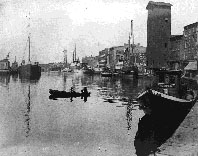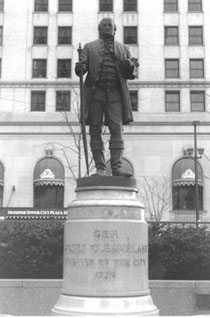| |
 |
| |
A bustling Cleveland on the Cuyahoga River, Ohio, ca. 1870 |
| |
 |
| |
Statue of founding father, Gen. Moses Clevealand, holding a staff and a surveyor's tool in Cleveland Public Square, dedicated in 1888. |
Moses Cleaveland (1754-1806) served during the American Revolution as a captain in one of the three companies of Sappers and Miners in the Corps of Engineers. A native of Connecticut, Cleaveland graduated from Yale University before entering the Army as a lieutenant in 1777. After the war Cleaveland practiced law, rose to the rank of brigadier general in the Connecticut militia, was a delegate to the state convention to ratify the U.S. Constitution, and served for more than 18 years in the general assembly.
Cleaveland took a special interest in western land speculation. He was one of 36 investors who formed the Connecticut Land Company in 1795 to develop 3.3 million acres in Connecticut’s Western Reserve (located in the northeast corner of present-day Ohio). Cleaveland became one of the company’s directors and superintendent-in-charge of surveying and settling the territory. In 1796, he led a party of 52 persons to negotiate with local Indian tribes, survey the land, and identify purchases.
That July, General Cleaveland landed at the mouth of the Cuyahoga River. Observing the surrounding country and proximity to the river and Lake Erie he decided it was an excellent location for a town. Cleaveland had the area laid out in lots and the members of his party named it Cleaveland in his honor.
The town grew slowly at first; the population reached only 150 by 1820. But Moses Cleaveland’s little town on the Cuyahoga was destined to become one of the leading cities of the region.
Legend has it that when Cleveland's first newspaper, The Cleveland Advertiser, was established in 1830, the editor dropped the "a" from Cleaveland’s name in order to fit the masthead on the page -- and the change stuck.
* * *
2000